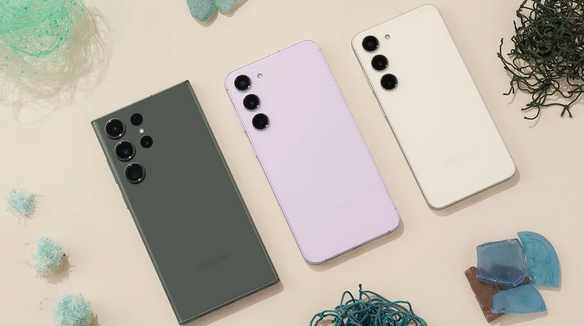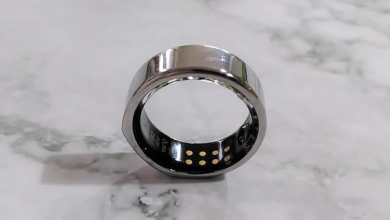Google Pixel 8 Pro vs Google Pixel 7 Pro: 12 key differences you need to know
Google's new AI-led flagship phone against its last


First, here are some of the key differences between the Pixel 8 Pro and its predecessor:
- Google Pixel 8 Pro is the most expensive Pixel phone yet
- 512GB storage option available in more markets than the Pixel 7 Pro
- New top 1TB storage option (US exclusive)
- New design with more rounded corners and frosted glass back
- New ‘Super Actua’ display boasts 60% higher peak brightness (2,400 nits)
- Upgraded cameras, including higher resolution 48MP ultra-wide
- Pixel 8 Pro gains a thermometer
- New lower-resolution 10.5MP front camera (down from 10.8MP)
- 3nm Google Tensor G3 chip (G2 uses 4nm node), plus 9 cores (up from 8) and higher clock speed
- Faster, more power efficient LPDDR5X RAM
- Android 14 and 7 years OS + security updates, compared to 3 and 5 years respectively on Pixel 7 Pro
- Fractionally larger 5,050mAh battery with faster 30W wired charger (27W on 7 Pro)
Google Pixel 8 Pro vs Google Pixel 7 Pro: Specs

While this doesn’t tell the whole story, let’s first take a look at the key specs of each device side by side.
| Google Pixel 8 Pro | Google Pixel 7 Pro | |
|---|---|---|
| Dimensions: | 162.6 x 76.5 x 8.8mm | 162.9 x 76.6 x 8.9mm |
| Weight: | 213g | 212g |
| Display: | 6.7-inch 1344 x 2992 20:9 adaptive 1Hz to 120Hz ‘Super Actua’ LTPO OLED | 6.7-inch 1440 x 3120 19.5:9 adaptive 10Hz to 120Hz LTPO OLED |
| Chipset: | Google Tensor G3 | Google Tensor G2 |
| RAM: | 12GB (LPDDR5X) | 12GB (LPDDR5) |
| Storage: | 128GB, 256GB, 512GB, 1TB (UFS 3.1) | 128GB, 256GB, 512GB (UFS 3.1) |
| Rear cameras: | 50MP wide, 48MP ultra-wide, 48MP 5x zoom | 50MP wide, 12MP ultra-wide, 48MP 5x zoom |
| Front camera: | 10.5MP | 10.8MP |
| Battery: | 5,050mAh | 5,000mAh |
| Charging: | 30W wired, 23W wireless (2nd-gen Pixel Stand), 12W wireless (Qi)30W wired, 23W wireless (2nd-gen Pixel Stand), 12W wireless (Qi) | 23W wired, 23W wireless (2nd-gen Pixel Stand), 12W wireless (Qi) |
| Colors: | Obsidian, Porcelain, Bay | Obsidian, Snow, Hazel |
Google Pixel 8 Pro vs Google Pixel 7 Pro: Price and availability

Just as the Pixel 6 Pro did before it, the Pixel 7 Pro arrived at a staring price of $899 / £849 / AU$1,299 for the 128GB model, while the 256GB 7 Pro cost $999 / £949 / AU$1,449 and the top-tier 512GB build cost $1,099 / AU$1,599 (which was never made available in the UK).
The Pixel 8 Pro starts with the same 128GB storage but now costs from $999 / £999 / AU$1,699; making it the priciest Pixel ever. This new pricing means it no longer undercuts and instead practically matches key rival the iPhone 15 Pro, while coming in on a sliver under the RRP for the base 256GB Samsung Galaxy S23 Plus (although nowadays you’ll find the Plus available with some degree of a discount).
| Header Cell – Column 0 | Google Pixel 8 Pro | Google Pixel 7 Pro |
|---|---|---|
| 128GB | $999 / £999 / AU$1,699 | $899 / £849 / AU$1,299 |
| 256GB | $1,059 / £1,059 / AU$1,799 | $999 / £949 / AU$1,449 |
| 512GB | $1,179 / £1,179 / AU$1,999 | $1,099 / AU$1,699 (not available in the UK) |
| 1TB (US only) | $1,399 (only available in US) | N/A |
In the US, you can also fork out for a new top-tier 1TB storage variant, which isn’t currently available elsewhere. However, you’ll pay $1,399 (approximately £1,150 / AU$2,200) for the privilege.
Google Pixel 8 Pro vs Google Pixel 7 Pro: Design and display

Google Pixel 8 Pro vs Google Pixel 7 Pro: cameras

On the tackle side, the cameras on the Pixel 8 Pro have completely migrated into the same lozenge- shaped cutout. The new 50MP detector now reportedly offers 21 lesser light perceptivity, meaning further- bettered low light performance including briskly autofocus in similar conditions.
The 7 Pro’s 12MPultra-wide had been replaced by a new 48MP detector that boasts 105 enhancement to how important light it takes in and lets you get indeed near to subjects, when shooting in Macro Mode. The 48MP 5x blowup, which we were introduced to on the 7 Pro, is now 56 further light sensitive.
There is also the new10.5 MP front- facing camera to touch on( the Pixel 7 Pro uses a10.8 MP fixed focus frontal camera), which now boasts autofocus. Now, let’s talk software advancements.
There are a host of new AI- supported features that are putatively tied to the phone’s Tensor G3 chip too, meaning we are doubtful whether Google can indeed include them in unborn Pixel point Drops for aged models, similar as the Pixel 7 Pro. Audio Magic Eraser can pick out different sound sources in vids and annihilate those you do not want. Stylish Take heists the stylish faces from a run of burst prints and lets you collate them into a final image where everyone’s got their stylish face on. Magic Editor lets you completely reframe an image, drag- and- drop subjects around and indeed restyle a blue sky to look like a evening and the suchlike.
Not only does a new set of Pro Controls allow for full- resolution 50MP image prisoner in RAW, you can also tweak ISO, shutter speed and focus. And as for videotape functionality, Video Boost promises to more capture skin tones and expose skies at right up to 4K resolution( vids are reused off- device and appear in the prints app, when ready), while the bettered light perceptivity on the 8 Pro’s main detector helps with the new Night Sight Video point.
All by each, if the Pixel 7 Pro set up a place on our rundown of the stylish camera phones, there is little reason to suggest the Pixel 8 Pro will not make an appearance on the list too,post-review.
Google Pixel 8 Pro vs Google Pixel 7 Pro: performance
With the Pixel 8 Pro, we now reach Google’s third-generation Tensor silicon, which – as ever – prioritizes AI smarts over raw number-crunching power. While we’re yet to benchmark the Tensor G3 inside the 8 Pro, there’s little to suggest it’ll give the Snapdragon 8 Gen 2 (inside phones like the OnePlus 11 and Samsung Galaxy S23 series) and the A17 Pro or A16 Bionic in any of Apple’s latest iPhone 15 series, in terms of straight performance.
That’s not to say it’ll feel lackluster; the Pixel 7 Pro and its Tensor G2 chip still feels great in everyday use one year on from release. But the examples in the camera section above highlight where the added processing strengths of the G3 lie above its predecessor.
While both phones pack in 12GB RAM, the 8 Pro technically packs faster and more power efficient LPDDR5X RAM, to the Pixel 7 Pro’s LPDDR5 memory, while storage is still UFS 3.1 across the board, with the only real distinction being the new 1TB configuration exclusive to the Pixel 8 Pro in the US. As mentioned earlier, the Pixel 7 Pro tops out at 512GB of storage and wasn’t ever released as a capacity in the UK (but is sold in the US and Australia).
There’s also the Pixel 8 series’ new software promise, which decimates anything that the company’s Pixels have offered before and even beats key rivals like Samsung and Apple, with an astounding seven years of OS, security and Pixel Feature Drop updates; up from three years of OS updates and five years of security updates on the Pixel 7 Pro.
Google Pixel 8 Pro vs Google Pixel 7 Pro: battery

When it comes to battery and charging, there’s no iPhone 15-like generational leap (the first iPhone series to adopt USB-C), moving from the Pixel 7 Pro to the Pixel 8 Pro. So until we’ve put the 8 Pro to the test, we’ve only got official figures and our experiences with the 7 Pro to work with for now.
Like Apple with its iPhones, Google doesn’t prioritize super-fast 120W charging, as you’d find on phones such as the recent Xiaomi 13T Pro, but there is a slight uptick in wired charging speeds between generations this year. The Pixel 7 Pro topped out at 27W charging when wired, with 23W wireless charging when using Google’s own second-generation Pixel Stand or 12W wireless charging using compatible Qi-standard chargers. The Pixel 8 Pro now ups that wired charging speed to 30W, no reaching the peak rate that Google’s own separately-sold USB-C Pixel charger.
As for battery longevity, there’s a move from a 5,000mAh to a 5,050mAh battery, while the Tensor G3 is built on a smaller, more power efficient 4nm node, compared to the Tensor G2’s 5nm die. Collectively this does imply we’ll see some – much needed – gains in terms of longevity, although the added benefits here could be balanced by the demanding new features on the Pixel 8 Pro.
While the Pixel 7 Pro can be an all-day phone, its weak screen-on time figures during review place it at the bottom end of this target. So fingers-crossed the 8 Pro delivers a little more in this department, as it looks like it should on paper.
Google Pixel 8 Pro vs Google Pixel 7 Pro: verdict
While the Pixel 7 Pro is still a wholly capable high-end phone, Google has improved on every major facet of it, save for battery (where the gains appear negligible). From the new chipset, to the new cameras, to Android 14 and the impressive seven-year software promise the Pixel 8 Pro takes the lead.
The big asterisk is, of course, price. With a new higher barrier to entry and a higher storage ceiling rendering the Pixel 8 Pro the most expensive Pixel ever. Meanwhile, the Pixel 7 Pro didn’t only start cheaper, it’s had a year to garner further discounts from various retailers. That means – so long as you don’t intend to hold onto it much past its software support lifecycle – it’ll still deliver a great all-round experience, with a particularly impressive camera that could potentially improve further with Google’s occasional Pixel Feature Drops.





